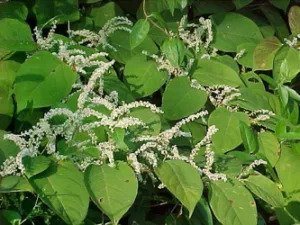Japanese Knotweed
Other Names: Polygonum cuspidatum, Rhizoma Polygoni Cuspidati, Bushy Knotweed Rhizome, Giant Knotweed, Japanese Knotweed Root, Polygoni Cuspidatum, Bambou Japonais, Bambou Mexicain, Extrait de Hu Zhang, Fallopia japonica, Fleece Flower, Giant Knotweed, He Shou Wu, Hu Zhang Extract, Hu Zhang Root, Itadori, Japanese Bamboo, Japanese Knotweed, Japanese Knotwood, Mexican Bamboo, PCWE, Persicaire Cuspidée, Polygoni Multiflora, Racine de Hu Zhang, Renouée à Feuilles Pointues, Renouée du Japon, Renouée Japonaise, Reynoutria japonica, Tiger Cane, Japanse duizendknoop, Japanischer Staudenknöterich,
Hu zhang is the Chinese name given to a plant with the scientific name of Polygonum cuspidatum. North American varieties are often referred to as “Mexican bamboo.” The root is used as medicine.
See also :
Contents
Special Precautions of Japanese Knotweed
Actions of Japanese Knotweed
antibacterial, antiviral, antischistosomal, antispirochetal, antifungal, immunostimulant, immunomodulant, anti-inflammatory, antioxidant, antiatherosclerotic, antihyperlipidemic, antimutagenic, anticarcinogenic, antineoplastic, vasodilator, inhibits platelet aggregation, inhibits eicosanoid synthesis, antithrombotic, tyrosine kinase inhibitor, oncogene inhibitor, antipyretic, cardioprotective, analgesic, antiulcer (slightly reduces stomach acid and protects against stress ulcers), hemostatic, and astringent.
Health Benefits and Uses of Japanese Knotweed
Polygonum cuspidatum Siebold & Zucc. is a natural plant that is widely distributed in China and Japan, and it is used in traditional Chinese herbal medicine. P. cuspidatum Siebold & Zucc. is rich with phenolics and has been used for the treatments of amenorrhea, arthralgia, jaundice, abscess, scald, and bruises (Lin et al., 2012). The main active ingredients in P. cuspidatum Siebold & Zucc. are epicatchin, resveratrol, and emodin
- Japanese Knotweed Root modulates and enhances immune function, is anti-inflammatory for both arthritic and bacterial inflammations, protects the body against endotoxin damage, and is a potently strong angiogenesis modulator, highly protective of the endothelia of the body. Its constituents cross the blood-brain barrier where they exert actions on the central nervous system: antimicrobial, anti-inflammatory, as protectants against oxidative and microbial damage. It is highly specific for bartonella infections and good, but of less importance, in mycoplasma infections.
- Ulcerative colitis : Root Extract of Polygonum cuspidatum Siebold & Zucc. Ameliorates DSS-Induced Ulcerative Colitis by Affecting NF-kappaB Signaling Pathway in a Mouse Model via Synergistic Effects of Polydatin, Resveratrol, and Emodin
- Lyme Disease : Japanese Knotweed Root is a very strong inhibitor of cytokine cascades initiated by bacteria. During Lyme infection, for instance, there is a spirochete-stimulated release of a number of matrix metalloptroteinases (MMPs) which occurs through a particular grouping of pathways. While there are a number of herbs that can reduce autoinflammatory conditions stimulated by MMP-1 and MMP-3 (for example Curcumin), the only herb that specifically blocks MMP-1 and MMP-3 induction through three particular pathways is Japanese Knotweed Root.
- Japanese Knotweed Root enhances blood flow, especially to the eyes, heart, skin, and joints. This makes it especially useful in Lyme and its coinfections as it facilitates blood flow to the areas that are difficult to reach to kill the organisms. The plant’s compounds easily move across the gastrointestinal mucosa and circulate in the bloodstream.
- Japanese Knotweed Root is an angiogenesis modulator, stimulating the formation of new blood vessels and the healing of damaged ones in areas such as burned skin, but also stops the development of new vessels and blood flow in areas where it should not occur, such as in malignant and benign tumor formation. It maintains the blood vessels themselves and as part of this action, has specific modulating and protectant actions on the endothelial cells that line the blood vessels
- Cancer : Until now, many active constituents of Polygonum cuspidatum have been found, such as resveratrol, polydatin, and anthraquinones (including emodin and its glycoside). It also contains flavonoids such as quercetin and (+)-catechin. A growing number of researches have shown that the effect of Polygonum cuspidatum and its active ingredients in cancer treatment is remarkable. Mainly resveratrol, polydatin, emodin, and chrysophanic acid are the active components of Polygonum cuspidatum in tumor diseases therapy.
- Resveratrol was originally extracted from the roots of Polygonum cuspidatum, which is also found in red wine, grapes, and peanuts. Many health benefits have been linked to it, including antitumor, anti-inflammation, antioxidation, immunoregulation, and even gut microbiota-regulation. Currently, resveratrol has attracted attention of researchers for its antitumor effect in a variety of human cancer cell lines through the regulation of various molecular targets. Its antitumor roles cover almost all aspects of cancer, including tumor cell proliferation, invasion, metastasis, apoptosis, immunity, metabolism, and intestinal flora.
- Polydatin induces apoptosis effectively with an increase in Bax expression and a decrease in Bcl-2 expression in lung cancer cells. In previous studies, polydatin, lonely or in combination with resveratrol, was found to inhibit growth and differentiation of Caco-2 cells.
- Emodin has been shown to have strong antitumor activity in oral cancer cells. It can inhibit the growth of oral cancer cells by reducing specificity protein 1 (Sp1) and induce caspase-dependent apoptosis, suggesting that emodin may be a potential bioactive substance to induce apoptosis.
- Chrysophanic acid, another active component of Polygonum cuspidatum, has antiproliferative effect on human breast cancer cells MCF-7 and MDA-MB-231, as well as the human colon cancer cells SW620.
